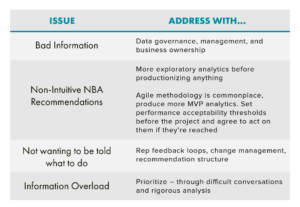Key Themes from Pharma Marketing USA 2022
With Pharma Marketing USA 2022 complete, here’s a guide to the resonating themes from this year’s conference – what leaders in the industry are strategizing around, where there’s consensus, and which key capabilities that organizations need were missing from the conversation.
Note: Panelists, speakers, vendors, and attendees were all fantastic! This was only a two-day conference to cover all the most important trends in our industry, so of course, a few key themes were missing.
Theme #1: Advanced Analytics Adoption Outpaces Clarity
Most firms claimed to be using what was often called “AI/ML” (said as one word). This makes sense, as there are great applications for advanced analytics in pharma marketing. We heard about folks leveraging AI for chatbots for experiences both on the patient and customer side. We also heard about ML use for omnichannel optimization, other recommendation algorithms, and natural language processing. Folks correctly pointed out ML is a great tool for partial or messy data. This makes it a key tool for pharma where structural factors, regulatory factors, or other macro factors mean partial/messy data is a given.
Missing from the conversation:
Analytics Literacy: The historic gap between strategy/data/operations teams, partners in the field, and other business stakeholders still exists. However, we need to get data literacy up across commercial if we’re going to be the analytics evangelists within the company and distinguish analytics approaches as our tools become more complex. I spoke to more than one vendor who admitted they were forced to call services “AI” that they themselves wouldn’t consider being AI. We’re marketers, and “AI” has tons of brand capital going back to Deep Blue, so it makes sense that the word gets overused. We’re great at understanding nuances of our data, on both the clinical and commercial side, but it’s time to apply that same depth of nuance to our analytics toolkit.
Match Analytical Tool with Application: I’ve done plenty of fully integrated ML applications for commercial teams – predictive analytics, unsupervised learning, and graph algorithms. These were for a specific task, like new-patient-start predictions, smart HCP targeting, and content recommendation. To me, real AI goes beyond solving a specific problem or building a model, and even ensemble modeling. A lot of problems don’t need ML. Often what’s needed is other modeling, augmented analytics, or advanced analytical methodologies. We have to match tool to problem, or we’ll waste time building the wrong solution.
Theme #2: Lagging Rep Buy-in for Next Best Action Frameworks
During Pharma Marketing USA 2022, we heard a lot about rep adoption. What they are asked to adopt is increasingly some form of a Next Best Action Framework – coordinating omnichannel activities in terms of content, sequence, and channel. Everyone understood their crucial role in the customer experience, at a minimum, as the vessel to deliver messaging in fundamental channels. However, their role was being questioned. No longer was there a strong consensus that a face-to-face call was the most impactful single event. One Next Best Action provider claimed clients were able to replicate the effectiveness of face-to-face calls with virtual assistants or call centers. There was less than I’ve heard in the past around “rep 2.0” or reps “quarterbacking” the omnichannel experience. Driven by post-COVID “new normal” call volumes, speakers mused if reps would even be around in 50 years.
What was taken as a given is that reps can be reluctant in relying on new information or guidance. There was some good conversation about “how” to get around this hesitance. We had great analogies around communication and change management using new tools (still using Google Maps to get home, even when you know where you live). There was discussion around rep feedback loops, the rep experience, and the benefits of effective data-sharing between the rep and HQ. We explored new ways of presenting information, like stories (as opposed to always dashboards), and making sure the fundamentals are right in any information presented.
Missing from the conversation:
Next Best Action (NBA) in Practical Terms: The NBA in provider engagement is becoming the new standard in omnichannel. This is the right goal to aspire to for commercial teams. One speaker correctly noted NBA is comprised of several capabilities: capturing data, analytics, orchestration, and measurement. What we didn’t hear is that measurement means tradeoffs. Models need target variables, and what you pick (i.e. maximize NewRx) has huge implications. Where were the war stories around the wacky results the validated NBA models have produced in practice? This is crucial because NBA models will produce unpopular recommendations. Approaching these the wrong way will lead to a tangle of contradictory business rules with a model hiding somewhere beneath. NBA models also need a nice suite of channels to work with. We need to talk less about channels like TikTok and more about tapping the broader ecosystem of HCP-centric digital hubs that influence treatment decisions today.
The rep themselves, and the “why”: I would have liked to see more around “why” we see this rep reluctance in the first place. Each “how” in getting adoption should address each “why” differently:
Theme #3: Data Centralization & Organizational Support Structures
Two foundational pieces of the analytical and digital excellence puzzle got quality airtime. The first was data management and centralization. We acknowledged how difficult it may be to centralize all data and how to prioritize. Panelists agreed data governance is intertwined with business goals. Agile was commonplace, as were its basic tenets, though some attendees I spoke weren’t sold on 8-12 week MVP deliveries of analytics. The data insight action pipeline is a given now, and there’s general agreement that data volume isn’t the issue. Leaders have had enough exposure to roadblocks in analytics to know the problem is much more around linking data, cleaning data, and data interoperability.
The second piece is the how, especially on the “people” side. More advanced analytics and data engineering services have been integrated into the business value pipeline they support. Titles may be shifting to reflect this. My quick and very unscientific analysis of the 46 speakers showed “Data” or “Analytics” in titles just as much as “Commercial,” and more than “Operations.” The “Operations” side is still crucial though, on both data>insight and the insight>action phase.
Missing from the conversation:
Knowledge Graphs (HCP Network Analysis): Every marketer understands the needs to develop 360 views of customer to maximize sales. However, a full 360 view of the customer really doesn’t exist without relationships. An HCP is connected directly to other targets by clinical trials, organization, practice, engagement, research, and so many other relationship types. Pharma companies often have this information but aren’t leveraging it appropriately. Centralization of data explodes in value when that data is centralized in a graph database, which is capable of visualizing and analyzing the entire network of customers and how they influence each other.
Structures that Enable an Effective Team: The “analytics team” is not a monolith, but a diverse set of skill sets. Teams need systems architects, data/analytics engineers, business analysts, data scientists, and data visualization experts – not to mention other technical support and functional counterparts on the business side. Not only do we need these roles, but we need the right mindset and skillset within each data and analytics team. The right person may need to fulfill multiple of these roles. Those teams also need the right suite of integrated modern tools that can support efficient data flows and complex models, and they’ll often need to build it themselves.
Honorable Mentions: Additional Pharma Marketing USA 2022 Topics
Modularized content magnifies customization: There was disagreement about what constituted modularized content. However, it’s an exciting opportunity for customization for messaging. The key, of course, is setting up the organization to use this framework effectively, meaning including the Medical, Legal, and Regulatory (MLR) team from outset and working with them to streamline pre-approval processes. What we missed is the analytics engine on the front end – to determine how to split content, and on the back end, to test/iterate and accurately validate performance. These iterative analytics should involve modular content inputs and outputs of NBA models.
Don’t forget medical is a channel, too: Some much-needed talk about the medical teams came late. Medical Science Liaisons (MSLs) represent crucial communication pathways with the customer. But (warranted) fears around regulations and commercial/medical firewalls has kept those teams even further behind commercial teams, who are already behind other industries when it comes to digital experiences and omnichannel optimizations. MSLs can be the more appropriate channel for customers depending on stage of the products lifecycle. This ties into data management and org structure, too. If the data function is aligned to commercial only, it will de-emphasize medical data needs.
No more excuses to be behind in digital excellence: We all agree – the strict regulatory environment we’re in is no excuse anymore. Other industries like finance are highly regulated and still can provide high-end digital experiences and multi-channel excellence. We need to realize the same customers in the life sciences are having those highly customized, fluid omnichannel experiences elsewhere, and will expect it from pharma, too.
Thank you to the speakers and leaders of the Pharma Marketing USA 2022 conference for sharing great forward-looking insight for the pharma industry!



